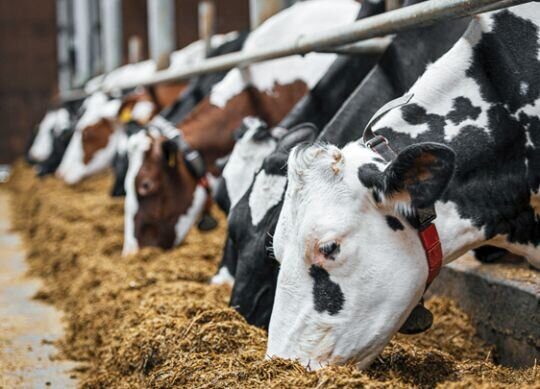Maintain Quality and Consistency in Your Feeding Program
A dairy operation’s ability to deliver a quality and consistent diet, day after day, has become an increasingly important goal for many nutritionists and producers. Why? Because the consistency of the ration, and feed and nutrition management, have influential impacts on the health of your herd and the operation’s bottom line.
Store feed properly to avoid excess moisture, molds or other factors that can cause shrink or degrade the feed ingredient
Obtaining and maintaining high-quality silage requires good forage management, especially in the areas of harvest, storage and feedout. Minimizing exposure to air, keeping silage coverings in place, ensuring a dense silage pile pack, maintaining a smooth feedout face and managing removal rates based on times of the year are all examples of efforts that can significantly reduce shrink. Make sure you don’t have extra silage remaining overnight in the summer months, as this will cause excessive heating.
One of the most important things to remember when harvesting corn silage is whole-plant moisture level. The desired level of whole-plant moisture will depend on whether the silage is stored in upright or horizontal silos. For bunkers and drive-over piles, the goal for whole-plant moisture is 66% to 68% and for vertical storage structures, 65% to 68% moisture.
When it comes to feeding strategies, consider blending silages to reduce moisture and nutrient variation and to dilute out any potential mycotoxins. When facing silage piles, tilt the face back slightly to reduce the risk of avalanches and collapses for safety reasons. During extreme heat, a good rule of thumb is to face it twice a day. Be sure to remember to remove any moldy or spoiled silage before facing.
Mix feed consistently every time and ensure equipment is in good working order
How feed is mixed impacts variation, and minimal variation is very important in keeping cows healthy and maintaining high milk production. Worn mixing equipment will increase the amount of time it takes to mix properly and decrease the quality of the mix – creating an increase in fuel costs. Monitoring and repairing these items as needed, such as kicker plates, is essential to maintain a high-quality total mixed ration (TMR). After the last ingredient is added, there is a tendency to quickly move the TMR to the bunk before it is adequately mixed. Increasing the final mix time from three to five minutes, depending on the type of mix and mixer, will allow for TMR to be properly blended. Routine maintenance and servicing are also crucial when it comes to keeping feed mixing equipment operating properly.
Deliver feed at the same time, in the same manner, every feeding
Cows crave consistent feed. It’s critical to feed pens as close to the same time every day so dry matter intake (DMI) stays as consistent as possible. Try to be within 20 minutes of the target time or the previous day’s time. Much like humans, these animals need a structured routine for activities, as well as specific nutrition to maximize performance, health and overall well-being. One way to monitor feeding times is to use feed tracking software that will record TMR drop times for each pen. You should review every week to see if your feeders are staying on track. Talk to the feeders to see if they are getting disrupted by truck drivers delivering hay and commodities to the dairy or if the feeder is trying to do other jobs during feeding. Recruiting, training and managing the labor responsible for ensuring the accurate and consistent delivery of feed has a big impact on a dairy’s overall performance and profitability.
Frequent feed push-ups and redistribution along the feedbunks as needed
Often, we see cows out of feed for as long as four to seven hours. Every pound of dry matter eaten results in 2 pounds of milk produced. Making sure cows have the nutrition they need will ultimately pay long-term dividends for a dairy operation. It’s very important to keep cows eating. Time-lapsed videos of feedbunks show that if cows can’t see the feed is up close, they will walk right by it. Keep feed pushed up at all times and redistribute as needed so all cows in the pen have access 24/7. The degree of overcrowding will dictate the frequency of pushups. More overcrowding requires more pushups. Start pushups one to two hours after the first feed drop and two to three hours after that. If producers desire a very low level of refusal, you might need to push up every hour, starting at midnight, until fresh feed delivery.
Delivering a consistent diet to cow’s day in and day out should be the goal for every dairy. Always remember to store feed properly, mix feed consistently, deliver feed routinely and push feed frequently. When done correctly, it will pay significant benefits in cow performance, feed efficiency and farm profitability.
Adapted from Tom Oelberg for Progressive Dairy.
Photo courtesy of Diamond V.



